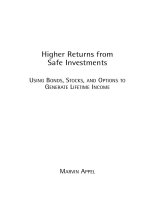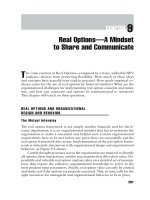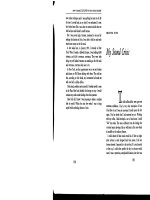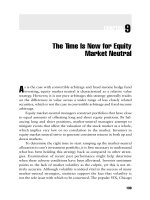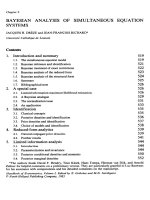Chapter 9 CFS
Bạn đang xem bản rút gọn của tài liệu. Xem và tải ngay bản đầy đủ của tài liệu tại đây (641.88 KB, 60 trang )
OPEN UNIVERSITY HCMC
MBA PREPARATORY COURSE
Principles of Financial
Accounting
Lecturer: NGUYEN TAN BINH
06/04/16
NGUYEN TAN BINH - PHAN DUC DUNG
1
Chapter 9
Statement of Cash Flows
06/04/16 NGUYEN TAN BINH - PH
2
Learning Objectives
After studying this chapter, you should be able to:
Explain the concept of the statement of cash
flows.
Classify activities affecting cash as operating,
investing, or financing activities.
Use the direct method to measure cash flows.
Determine cash flows from income statement
and balance sheet accounts.
Use the indirect method to calculate cash flows
from operations.
06/04/16 NGUYEN TAN BINH - PH
3
Learning Objectives
After studying this chapter, you should be able to:
Relate depreciation to cash flows provided by
operating activities.
Reconcile net income to cash provided by
operating activities.
Adjust for gains and losses from fixed asset sales
and debt extinguishments in the statement of
cash flows
06/04/16 NGUYEN TAN BINH - PH
4
Overview of Statement
of Cash Flows
The statement of cash flows provides a
thorough explanation of the changes that
occurred in a firm’s cash balance during the
entire accounting period.
The statement of cash flows reports cash receipts
and payments of a company during a given period
for operating, financing, and investing activities.
“Cash” includes cash and cash equivalents.
06/04/16 NGUYEN TAN BINH - PH
5
Purposes of Cash Flow
Statement
The FASB requires a statement of cash flows.
It shows the relationship of net income to changes in cash
balances.
It reports past cash flows as an aid to:
Predicting future cash flows
Evaluating the way management generates and uses
cash
Determining a company’s ability to pay interest and
dividends and to pay debts when they are due
It identifies changes in the mix of productive assets.
06/04/16 NGUYEN TAN BINH - PH
6
Purposes of Cash Flow
Statement
The statement of cash flows, along with the
income statement, explains why balance sheet
items have changed during the period.
The balance sheet shows the status of a
company at a point in time.
The statement of cash flows and the
income
statement show the performance of a company over a
period of time.
06/04/16 NGUYEN TAN BINH - PH
7
Typical Activities Affecting
Cash
Cash is affected by two primary areas of a
firm.
Operating management - largely concerned with
the major day-to-day activities that generate
revenues and expenses
Financial management - largely concerned with
where to get cash and how to use cash for the
benefit of the entity
06/04/16 NGUYEN TAN BINH - PH
8
Typical Activities Affecting
Cash
Operating activities - transactions that affect
the income statement
Investing activities - activities that involve
(1) providing and collecting cash as a lender
or as an owner of securities and (2) acquiring
and disposing of plant, property, equipment,
and other long-term productive assets
Financing activities - activities that include
obtaining resources as a borrower or issuer of
securities and repaying creditors and owners
06/04/16 NGUYEN TAN BINH - PH
9
Typical Activities Affecting
Cash
Typical operating activities
Cash inflows
Collections from
customers
Interest and
dividends collected
Other operating
receipts
Cash outflows
Cash payments to
suppliers
Cash payments to
employees
Interest and tax
payments
Other operating cash
payments
06/04/16 NGUYEN TAN BINH - PH
10
Typical Activities Affecting
Cash
Typical investing activities
Cash inflows
Sale of property,
plant, and equipment
Sale of securities
that are not cash
equivalents
Receipt of loan
repayments
Cash outflows
Purchase of property,
plant, and equipment
Purchase of securities
that are not cash
equivalents
Making loans
06/04/16 NGUYEN TAN BINH - PH
11
Typical Activities Affecting
Cash
Typical financing activities
Cash inflows
Borrowing cash from
creditors
Issuing equity
securities
Issuing debt
securities
Cash outflows
Repayment of
amounts borrowed
Repurchase of equity
shares (including
treasury stock)
Payment of dividends
06/04/16 NGUYEN TAN BINH - PH
12
Approaches to Calculating the
Cash Flow from Operating Activities
Two approaches may be used to compute cash flow
from operating activities.
Direct method - the method that calculates net cash
provided by operating activities as collections minus
operating distributions
Indirect method - the method that adjusts the accrual
net income to reflect only cash receipts and outlays
Under either method, the final cash flow from
operating activities will be the same.
06/04/16 NGUYEN TAN BINH - PH
13
Approaches to Calculating the
Cash Flow from Operating Activities
Under the direct method, income statement
amounts are adjusted for changes in related asset
and liability accounts.
Each revenue and expense account calculated under
the accrual method is adjusted to reflect the actual
cash paid or received.
Under the indirect method, accrual net income is
adjusted to reflect only cash transactions.
06/04/16 NGUYEN TAN BINH - PH
14
Approaches to Calculating the
Cash Flow from Operating Activities
The FASB prefers the direct method because it
shows operating cash receipts and payments
in a way that is easy for investors to
understand.
The indirect method is more common because
many people are used to thinking in terms of
net income.
06/04/16 NGUYEN TAN BINH - PH
15
Transactions Affecting Cash
Flows from All Sources
Effects of operating transactions on cash:
Sales of goods and services for cash
+
Sales of goods and services on credit
0
Receive dividends or interest +
Collection of accounts receivable +
Recognize cost of goods sold 0
Purchase inventory for cash Purchase inventory on credit 0
Pay trade accounts payable “0” denotes that the transaction has no effect on cash.
06/04/16 NGUYEN TAN BINH - PH
16
Transactions Affecting Cash
Flows from All Sources
Effects of operating transactions on cash:
Accrue operating expenses 0
Pay operating expenses
Accrue taxes
0
Pay taxes Accrue interest 0
Pay interest
Prepay expenses for cash
Write off prepaid expenses 0
Charge depreciation or amortization
0
06/04/16 NGUYEN TAN BINH - PH
17
Transactions Affecting Cash
Flows from All Sources
Effects of investing activities on cash:
Purchase fixed assets for cash
Purchase fixed assets by issuing debt
0
Sell fixed assets +
Purchase securities that are not cash equivalents
Sell securities that are not cash equivalents
+
Make a loan
-
06/04/16 NGUYEN TAN BINH - PH
-
18
Transactions Affecting Cash
Flows from All Sources
Effects of financing transactions on cash:
Increase long-term or short-term debt
+
Reduce long-term or short-term debt
Sell common or preferred shares
+
Repurchase or retire common or preferred shares
Purchase treasury stock
Pay dividends
Convert debt to common stock
0
Reclassify long-term debt to short-term debt 0
06/04/16 NGUYEN TAN BINH - PH
-
19
Cash Flow and Earnings
The income statement and the statement of
cash flows fill different critical information
needs.
The income statement shows how a
company’s
owners’ equity changes as a result of operations.
It matches revenues and expenses
using the accrual concept and provides
a measure of economic activity.
The statement of cash flows focuses on the net cash
flow from operating activities.
06/04/16 NGUYEN TAN BINH - PH
20
A Detailed Example
of the Direct Method
ECO-BAG COMPANY
Balance Sheet (in thousands)
December 31, 20X3 and 20X2
Current assets: Current liabilities:
Cash $ 16 $ 25
Accounts payable
$ 74 $ 6
Accounts receivable
45
25
Wages and salaries payable
4
Inventory
100
60
Total current assets $161 $110
Total current liabilities
10
Fixed assets, gross
581
330
Long-term debt
125
5
Accum. depreciation
(101)
(110)
Stockholders’ equity
315
Net
480
220
Total liabilities and
Total assets
$641 $330 stockholders’ equity
$641 330
06/04/16 NGUYEN TAN BINH - PH
25
99
417
21
A Detailed Example
of the Direct Method
ECO-BAG COMPANY
Statement of Income (in thousands)
for the Year Ended December 31, 20X3
Sales
Costs and expenses:
Cost of goods sold
$100
Wages and salaries
Depreciation
Interest
4
Total costs and expenses
Income before income taxes
Income taxes
Net income
$200
36
17
06/04/16 NGUYEN TAN BINH - PH
157
43
20
$ 23
22
A Detailed Example
of the Direct Method
ECO-BAG COMPANY
Statement of Cash Flows (in thousands)
for the Year Ended December 31, 20X3
CASH FLOWS FROM OPERATING ACTIVITIES:
Cash collections from customers
$ 180
Cash payments:
To suppliers $ 72
To employees
15
For interest
4
For taxes
20
Total cash payments
(111)
Net cash provided by operating activities $ 69
06/04/16 NGUYEN TAN BINH - PH
23
A Detailed Example
of the Direct Method
ECO-BAG COMPANY
Statement of Cash Flows (in thousands)
for the Year Ended December 31, 20X3
(continued)
CASH FLOWS FROM INVESTING ACTIVITIES:
Purchases of fixed assets
$(287)
Proceeds from sale of fixed assets
10
Net cash used by investing activities
(277)
06/04/16 NGUYEN TAN BINH - PH
24
A Detailed Example
of the Direct Method
ECO-BAG COMPANY
Statement of Cash Flows (in thousands)
for the Year Ended December 31, 20X3
(continued)
CASH FLOWS FROM FINANCING ACTIVITIES:
Proceeds from issue of long-term debt $120
Proceeds from issue of common stock
98
Dividends paid
(19)
Net cash provided by financing activities
Net decrease in cash
(9)
Cash, December 31, 20X2
25
Cash, December 31, 20X3
$ 16
199
06/04/16 NGUYEN TAN BINH - PH
25



